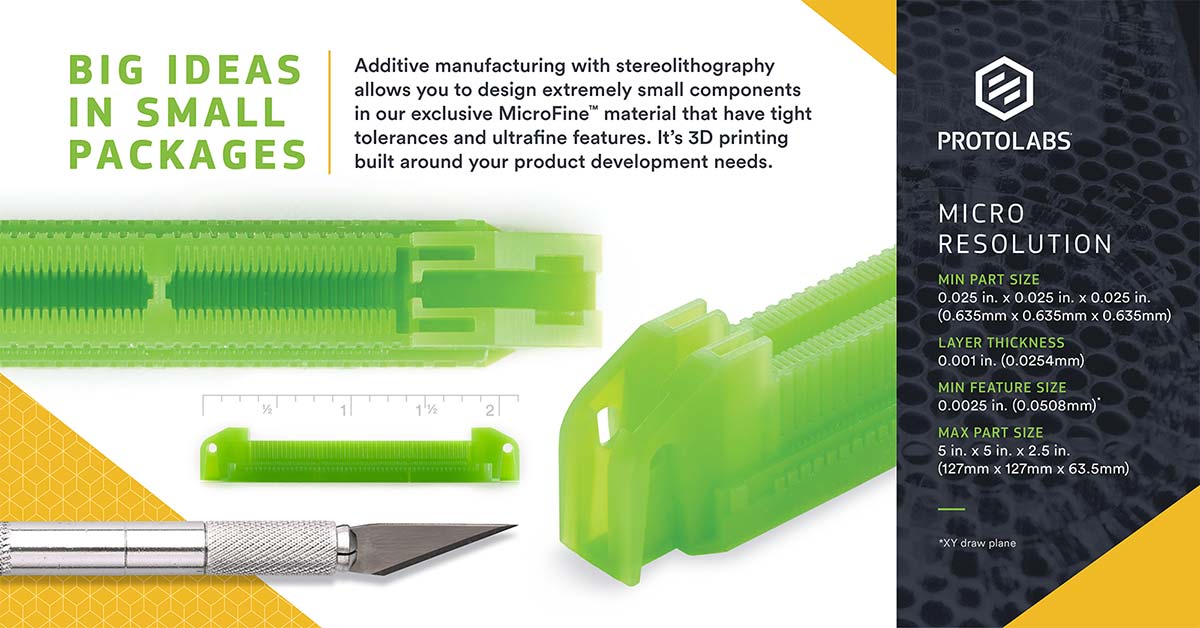
When building a part with 3D printing, the machine’s resolution can have a significant impact on the final part by determining the minimum feature size, surface finish quality, and cost. To accommodate for a range of part geometries, we offer sterolithography (SLA) 3D printing in three resolutions: normal, high, and micro. Most parts can be built in normal resolution, but for parts with fine features around 0.005 in., high resolution may be required.
For the times when feature size is extremely small, such as 0.0025 in., we offer micro resolution. We can achieve these ultrafine features with our exclusive material, MicroFine™. This thermoset resin builds parts in 0.001 in. layers. The max. part size is 5 in. by 5 in. by 2.5 in., and offers extremely tight tolerances. Most parts built in MicroFine™ are no more than 1 in. by 1 in. by 1 in.
Have a part design that might require this level of resolution? Here’s what to know if you’re considering MicroFine for your next project.
SLA Tech and Build Process
Our MicroFine parts are built with 3D Systems Vipers that have been modified and optimized for micro-resolution. Like all of our 3D printing processes, we run in-process controls to ensure parts are built accurately and conduct quality inspections after the build is complete to ensure accurate parts.
The post-build processing is nearly identical to SLA parts built in other materials. It’s first cleaned with solvents and then fully cured in a UV oven. After that, we remove the support structures and sand it down for a smooth surface finish. If the customers’ parts is a standard finish, we grit blast the part. For parts that are extremely small, we may sometimes forgo the grit blasting if there is a risk of damaging parts.

Material Properties
As the name implies, MicroFine™ is available in green and gray colors. In terms of its mechanical properties, the material is fairly durable, rigid, and most similar to an ABS plastic. Smaller features built in MicroFine™ tend to be more durable than similar 3D printing materials. It’s stiffer than WaterShed—our clear, microfluidic material—but fine features will be much more durable compared to polycarbonate-like materials such as Accura 60. For a more thorough breakdown of 3D printing materials, view this extensive guide.
Here’s how MicroFine™ compares to other ABS-like materials used in SLA:
| MicroFine™ | Huntsman RenShape | Somos WaterShed | |
|---|---|---|---|
| Tensile Strength | 6.5 ksi | 5.2 - 7.4 ksi | 6.8 - 7.8 ksi |
| Tensile Modulus | 305 ksi | 290 - 362 ksi | 296 - 344 ksi |
| Elongation at Break | 6.1% | 8 - 18% | 11 - 20% |
| Heat Deflection Temp. | 138 Degrees F | 125 Degrees F | 130 Degrees F |
Applications
The primary use of MicroFine™ is for rapid prototyping of parts with extremely fine features. The material isn’t quite durable enough for most end-use applications. Most of our customers using this material are prototyping small components in medical devices. Another common application is custom fixtures for researchers in a range of fields.






